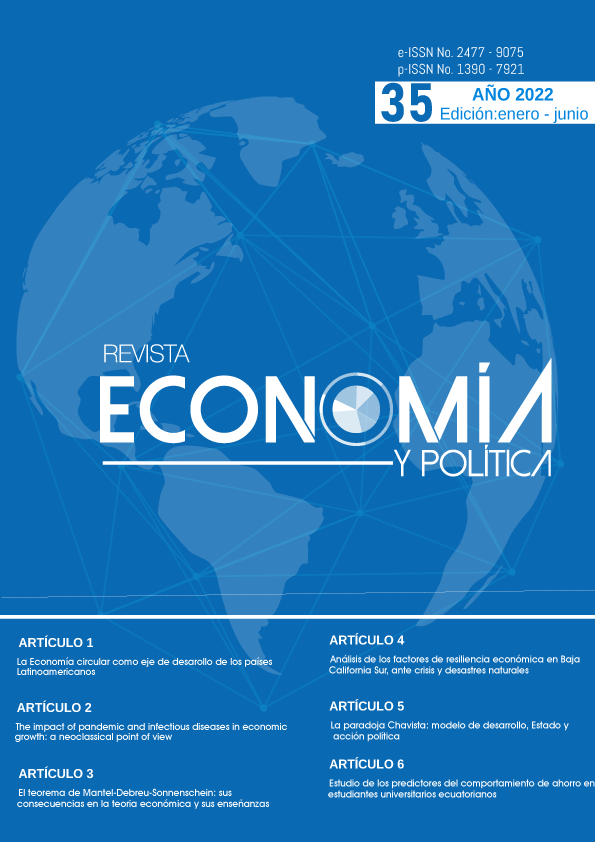The impact of pandemic and infectious diseases in economic growth: A neoclassical point of view
DOI:
https://doi.org/10.25097/rep.n35.2022.02Palabras clave:
Pandemic, Economic Growth, Richard Function, Poverty TrapsResumen
Desarrollamos un modelo de crecimiento neoclásico en el que introducimos la función de producción de Richard para describir el impacto de las enfermedades infecciosas y pandemias que afectan en la oferta. El modelo muestra que, en proporción al impacto exógeno, los países con un bajo nivel de desarrollo tecnológico en sus sectores productivos, reducen su productividad laboral y bajo ciertas condiciones pueden caer en una trampa de pobreza. Mientras que países con alto nivel de desarrollo tecnológico, también reducen su productividad laboral, pero tienen una rápida recuperación. Mostramos que la incorporación de tecnología moderna y las mejoras en capital humano son condiciones necesarias para salir de la trampa de pobreza.
Descargas
Citas
Accinelli, E., Brida, J. G. (2007). The dynamics of the Ramsey economic growth model with the von Bertalanffy population growth law. Applied Mathematical Sciences, Vol. 1(No. 2), pp. 109–118.
Acemoglu, D. (2002). Technical change, inequality, and the labor market. Journal of Economic Literature, Vol. 40(No. 1), pp. 7- 72.
Acemoglu, D., Johnson, S. (2007). Disease and development: The effect of life expectancy on growth. Journal of Political Economy, Vol. 115(No. 6), pp. 925-985.
Acemoglu, D., Zilibotti, F. (2001). Productivity differences. The Quarterly Journal of Economics, Vol. 116(No. 2), pp. 563–606.
Agénor, P. (2015). Public capital, health persistence and poverty traps. Journal of Economics, Vol. 115, pp. 103–131.
Azariadis, C. (2006). The Theory of Poverty Traps, what have we learned? In S. Bowles (Ed.), Poverty traps (pp. 19–40). Pricenton University Press.
Azariadis, C., Drazen, A. (1990). Threshold Externalities in Eco- nomic Development. The Quarterly Journal of Economics, Vol. 105(No. 2), pp. 501–526.
Azariadis, C., Stachurski, J. (2005). Poverty Traps. In P. Aghion S. Durlauf (Eds.), Handbook of economic growth (Vol. 1A, pp. pp. 295–384). Elsevier.
Bell, D., Blanchflower, D. (2020). US and UK labor markets before and during the covid-19 crash. National Institute Economic Review, Vol. 252, pp. R52-R69.
Bick, A., Blandin, A. (2020, January). Real-time labor market estimates during the 2020 coronavirus outbreak. SSRN Electronic Journal.
Biddle, J. (2014). The cyclical behavior of labor productivity and the emergence of the labor hoarding concept. Journal of Economic Perspectives, Vol. 28 (No. 2), pp. 197-212.
Brida, J. G. (2008). Población y crecimiento económico una versión mejorada del modelo de Solow. El Trimestre Económico, Vol. 75, pp. 5-22.
Chou, J., Kuo, N., Peng, S. (2004). Potential impacts of the Sars outbreak on Taiwan’s economy. Asian Economic Papers, Vol. 3(No. 1), pp. 84-99.
Coibion, O., Gorodnichenko, Y., Weber, M. (2020). The cost of the covid-19 crisis: Lockdowns, macroeconomic expectations, and consumer spending (Working Paper Series No. 27141). National Bureau of Economic Research.
Dossche, M., Gazzani, A., Lewis, V. (2021). Labor adjustment and productivity in the OECD (Working Paper Series No. 2571). European Central Bank.
Englmann, F. (1994). A Schumpeterian model of endogenous in- novation and growth. Journal of Evolutionary Economics, Vol. 4(No. 3), pp 227-241.
Fermand, J., Wang, J. (2016). Why has the cyclicality of productiv ity changed? what does it mean? Annual Review of Economics, Vol. 8(No. 1), pp. 465-496.
Ferrara, M., Guerrini, L. (2009). The Ramsey model with logistic population growth and Benthamite felicity function revisited. WSEAS Transactions on Mathematics, Vol. 8(No. 3), pp. 97– 106.
Foster, J., Wild, P. (1999). Econometric modelling in the presence of evolutionary change. Cambridge Journal of Economics, Vol. 23(No. 6), pp. 749-770.
Goenka, A., Liu, L. (2020). Infectious diseases, human capital and economic growth. Economic Theory, Vol. 70, pp. 1–47.
Guerrini, L. (2006). The Solow-Swan model with a bounded population growth rate. Journal of Mathematical Economics, Vol. 42(No. 1), pp. 14–21.
Guerrini, L. (2010). A closed-form solution to the Ramsey model with logistic population growth. Economic Modelling, Vol. 27(No. 5), pp. 1178–1182.
Hai, W., Zhao, Z., Wang, J., Hou, Z. (2004). The short-term impact of Sars on the chinese economy. Asian Economic Papers, Vol. 3(No. 1), pp. 57-61.
Inada, K. (1963). On a Two-Sector Model of Economic Growth: Comments and a Generalization. The Review of Economic Stud ies, Vol. 30(No. 2), pp. 119-127.
Lucas, R. E. (1988). On the mechanics of economic development. Journal of Monetary Economics, Vol. 22, pp. 3–42.
Plata, L., González, P., Calderón, E. (2017). La función de crecimiento de Richard y los modelos de crecimiento neoclásicos. EconoQuantum, Vol. 14 (Num. 1), pp. 99-118.
Reati, A. (1998). Technological revolutions in Pasinetti’s model of structural change: productivity and prices. Structural Change and Economic Dynamics, Vol. 9 (No. 2), Pages 245–262.
Richard, F. (1959). A flexible growth function for empirical use. Journal of Experimental Botany, Vol. 10 (No. 29), pp. 290-300.
Romer, P. (1986). Increasing returns and long-run growth. Journal of Political Economy, Vol. 94 (No. 5), pp. 1002-1037.
Sachs, J., McArthur, J., Schmidt-Traub, G., Kruk, M., Bahadur, C., Faye, M., McCord, G. (2004). Ending Africa’s poverty trap. Brookings Papers on Economic Activity (No. 1), pp. 117-240.
Scarpello, G., Ritelli, D. (2003). The Solow model improved through the logistic manpower growth law. Annali dell’Universita di Ferrara, Vol. 49 (No. 1), pp. 73-83.
Siu, A., Wong, R. (2004). Economic impact of Sars: The case of Hong Kong. Asian Economic Papers, Vol. 3(No. 1), pp. 62-83.
Solow, R. (1964). Draft of presidential address on the short run relation of employment and output. In D. Rubenstein (Ed.), Robert Solow papers. Box 70, Dated 1964.
Wray, L. R. (1991). Saving, profits, and speculation in capitalist economies. Journal of Economic Issues, Vol. 25(No. 4), pp. 951-975.
Publicado
Cómo citar
Número
Sección
Licencia
Derechos de autor 2022 Revista Economía y Política

Esta obra está bajo una licencia internacional Creative Commons Atribución-NoComercial-CompartirIgual 4.0.







